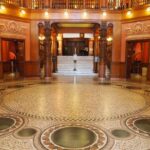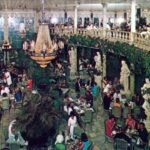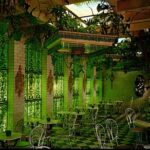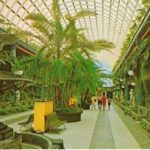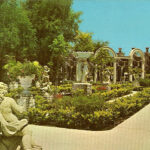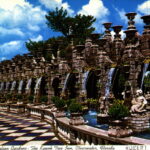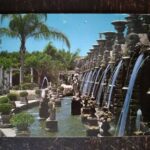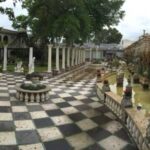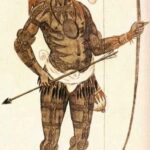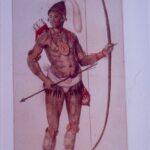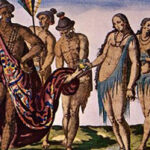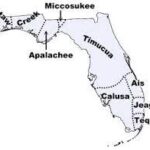Imperial Rome and Italy Superior is a necessary post to explain the Venetian (Italian) influence of Florida, formally, called La floridas, which means the land of the flowers.





























The Venetians are named after their city Venice, Italy, which is a city built around water with a serious of water canals. Likewise, Florida is a state with thousands of water canals similar to the ones in Venice, Italy. Venice was established by those Phoenician Moors that conquered the Iberian Peninsula, Spain, Italy, etc., which explains why Venice is a water canal city since the Moors as mariners were sea people (see image of Phoenician Maur); and this also explains the Moorish/ Tartarian architecture found all throughout Venice, Italy.
The Phoenicians were initially the Naga-Maya (Mayans) that civilized the world after their home Teotihuacan (the capital of Atlantis) had sunk (see blog post, “Teotihuacan is the home of Thoth). In addition, the Phoenicians are also from the Americas: https://www.americaistheoldworld.com/the-phoenicians-are-from-the-americas/.
These Naga-Maya (Phoenicians/ Atlanteans/ Egyptians) came to Florida and built the Moorish/ Tartarian architecture throughout Florida: https://www.americaistheoldworld.com/gibraltar-of-the-west/.
In this post are images of the Kapok Tree Inn and its exotic Italian (Venetian) restaurant, which is located around the Sam Ash Music Store, in Clearwater, Florida, near Tampa Bay (Bey) and by the Bay bridge. The Venetian Gothic Architecture (Moorish or Tartarian Architecture) is amazing. Imagine how this place looked like in her prime! The Kapok Tree is the Sacred Tree of the Aztecs (Atlanteans) and Mayans (Egyptians), so yes…, Phoenician Mayans (Moors/ Tartars) built this. This place has two Medici lions at its entrance, which are a symbol of Florence, Italy.
The city of Florence was established by Julius Caesar, around 59 BC, as a settlement for his veteran soldiers and was named originally Fluentia, because it was built between two rivers, which was later changed to Florentia (“flowering”). Florentia sounds a lot like Florida, which also means Flowers or the land of flowers. In 1513, Spanish explorer Juan Ponce de Leon named the state La Florida – “Land of Flowers” – for the Easter season in which he made his discovery.
Italy and Florida and both shaped like boots:
Also, Florida and Italy are both shaped like boots, and they are both Peninsula’s. The only difference is that Florida is shaped like an upside-down boot. We know that Rome is in Italy, so Florida being shaped like the Country of Italy suggests that the original Italy was in the Americas, which equates to the original Rome being in the Americas by default since Rome is in Italy.
Additionally, Italy and Florida share some of the same city place names, such as: Naples, Venice, Florence, and Milan. We can also Include Rome, Georgia, since Florida is attached to Georgia and Florida used to be a huge territory of land called La Floridas (Tameri), which included Georgia, most of North America, and some parts of Canada and Mexico. Georgia also has a Milan and a Florence.
Yes, the European Italy (Rome) was patterned after greater Italy or Italy Superior that was called La floridas. I say this because Ancient Rome and Greece was in the Americas: https://www.americaistheoldworld.com/ancient-greece-and…/.
Additionally, the first Vatican City was in Mexico near the Capital of Atlantis, which was Teotihuacan: https://www.americaistheoldworld.com/teotihuacan-is-the…/.
Alessandro de’ Medici (22 July 1510 – 6 January 1537), nicknamed “il Moro” (the Moor) due to his dark complexion, Duke of Penne and the first Duke of the Florentine Republic (from 1532), was ruler of Florence from 1530 to his death in 1537. He was the first Medici to rule Florence as a hereditary monarch, Alessandro was also the last Medici from the senior line of the family to lead the city. His assassination at the hands of distant cousin Lorenzaccio caused the title of Duke to pass to Cosimo I de Medici, from the family’s junior branch.
The Medici family was very powerful in medieval history, since there were several Pope’s in the Medici family, one of them was Pope Leo XI. Pope Leo XI (Italian: Leone XI; 2 June 1535 – 27 April 1605), born Alessandro Ottaviano de’ Medici, was head of the Catholic Church and ruler of the Papal States from 1 April 1605 to his death.[1] His pontificate is one of the briefest in history, having lasted under a month. He was from the prominent House of Medici originating from Florence.[2]
The Medici family resigned from the Papal States, due to infighting stemming from this family not wanting to be a part of the now corrupted Papal States. However, when you are a part of an organized gang (the Vatican) you can’t just leave without war/ fighting, hence the ole true saying, “Once you are in you can’t get out.”
As a result of the conflict between the Medici’s and the Vatican, the Medici’s created the Medici lion. This lion is known as the Medici Lion because it once belonged to Grand Duke Ferdinando I de’ Medici and adorned Villa Medici, his home in Rome, until they were moved to Loggia in 1789. This lion is called Marzocco (Morocco*?) and is a symbol of protection for the city of Florence, Italy, aka, the Free Republic of Florence, Italy against the imperial Eagle of Rome.
The heraldic lion is the animal symbol representing the free Republic of Florence. As the legend goes, the Florentine Republic chose the symbol of the lion over other animals because lions can tear apart the Imperial eagle of Rome, which is the symbol of imperial power: https://www.florenceinferno.com/marzocco-symbol-of-florence/.
Two Medici Lions at the Whitehall Hotel:
In addition, at Whitehall in West Palm Beach, Florida, the Home of Robber Baron, “Henry Morisson Flagler,” there is a fabulous Venetian (Phoenician) mansion by the water that also has two Medici Lions at the front entrance with a giant Kapok Tree of the Mayans on the property: https://www.youtube.com/watch?v=shNollkkukQ&t=10s. The middle name of Flagler is Morisson and it means “son of the Moor.” Could Flagler really be the son of a Moor or the conqueror of the Moors since he claimed towns and properties that belonged to the Moors? It was a little bit of both.
Whitehall was initially the Whitehall Hotel with a Moorish red roof (see post image), but now it is called the Whitehall Museum. This building even has a small train station attached to it that is made from copper and it has an old train inside of the station (see post images).
The Lion Gate Bridge:
We must also consider the Lion Gate Bridge in Saint Augustine Florida since it is also Venetian Gothic Architecture. This bridge has a Medici Lion named Marzocco at the entrance of the Lion Gate (see post image), which leads directly to the House of the Lion, which translates in Spanish as “Ponce de Leon.” Ponce de Leon is now part of Flagler College. The flag of Flagler College is a red crest or shield with a golden Medici Lion on it, which supports the fact that Ponce de Leon means, “House of the Lion.”
In addition, here is a throwback image from the late 1800’s of the front entrance of the Ponce de Leon Hotel shows you a medieval-style castle draw bridge or gate with two pillars of Tartarian red brick masonry that are decorated with the face of a Medici Lion on each pillar of masonry, so yes…, Ponce de Leon means the House of the Lion, based upon the evidence. This lion is called Marzocco (Morocco*?) and is a symbol of protection for the city of Florence, Italy, aka, the Free Republic of Florence against the Imperial Eagle of Rome.
Saint Augustine, Florida is oldest city in America allegedly founded in 1565 by a Spanish admiral, which is 40 years older than the founding of Jamestown Virginia. St. Augustine is the oldest continuously occupied European settlement in the continental U.S. Tourist attractions include two national monuments that are sites of old Spanish forts: Castillo de San Marcos and Fort Matanzas.
The city is also known for its spectacular Moorish Revival and Spanish Renaissance Revival buildings from the late 19th century. These include the former Hotel Alcazar and Ponce de Leon Hotel, both built by industrialist Henry Flagler. The Alcazar now houses St. Augustine City Hall and the Lightner Museum, which is known for its collection of 19th century fine and decorative art. The Ponce de Leon is now part of Flagler College.
The Ponce de Leon Hotel:
The Ponce de Leon Hotel is one of the most extravagant and luxurious pieces of property in the world. It is located at 74 King Street and on the corner of Granada Street. Wow, what a location since King means sovereign ruler and Granada is Spanish for the pomegranate fruit, which is a symbol of the Promised Land of Jerusalem, when this fruit is fully bloomed, since it resembles the shape of the 6-pointed Star of David. Yes, Granada Land (the promised land) was in the Americas, and it covered La Floridas, parts of Canada, Mexico, Central America, and South America: https://www.americaistheoldworld.com/granada-land-is-the-promised-land-of-israel/.
According to the Torah (Old Testament of the Bible), Jewish tradition teaches that the pomegranate is a symbol for righteousness because it is said to have 613 seeds that corresponds with the 613 mitzvot or commandments of the Torah. In some artistic depictions, the pomegranate is found in the hand of Mary, mother of Jesus.
The pomegranate plant arrived in Rome via Carthage, which explains why the ancient Romans referred to pomegranate fruits as ‘apples of Carthage’ (Tunis=Tennessee). The people of Carthage were a branch of the Phoenicians. Pomegranate is known in Egyptian Hieroglyphics as “Ramen.” In Hebrew Rimon, means pomegranate. Both Ramen and Rimon are the origin of the term Roman, which means Promised Land.
Florida also has a Granada in Sarasota, Florida. Granada was a stronghold for the Moors of Spanish Iberia. However, the original Iberian Peninsula and Hispaniola (Spain) was in La Floridas, which was a huge territory of land once. Please refer to the above blog post, “Gibraltar of the West,” for evidence on this. Now that we know the significance of Granada let’s look at some of the images of the Ponce de Leon Hotel.
The Venetians/ Phoenicians were a highly Advanced Nation of people with Flying Machines and Free Energy Technology:
In this post is a colorized image from the late 1800’s of a blimp getting ready to land on one of the two landing platforms (towers) to choose from at the Ponce de Leon Hotel. The blimp anchors to one of the towers and a landing bridge comes out to connect the blimp with the tower so that the flight attendants on the blimp could make a grand entrance into this fabulous Venetian Gothic Castle, known as the ponce de Leon Hotel (see post images of a blimp anchored to the skyscraper’s tower for an example).
The two towers in the blimp image also serve as hydro-electric towers/ generators that supplied free hydro-electric energy (free Energy) generated from steam (water), since one tower is the anode (the male or positive charge from the hot water that it stored) and the other tower is the cathode (the female or negative charge from the cold water that it stored).
More evidence of free energy is the Ponce de Leon green steam dragons that once served as high pressure release valves to release hot steam (fire) from the structure when the lights were turned on (see post image of green steam dragon). These green steam dragons had a red-light bulb in their mouths to resemble fire breathing dragons when the power was turned on during the nighttime.
In this post are some aerial views of the Ponce de Leon hotel to show you how vast this Venetian Gothic Castle/ Mansion is. The main entrance room of the Ponce de Leon Hotel features an 8-pointed rotunda on the ceiling with a polished marble mosaic floor. The ceilings are decorated with remarkable mural paintings, which have been whitewashed. The ballroom now called the Flagler room has 12 Austrian Crystal chandeliers.
The inside is immaculate since all the wood inside is made of Cypress wood. Cypress wood is the second most expensive wood in the world, because it is fire resistant, bug resistant, water resistant, and rot resistant. Cypress wood can last forever, and its oil or resin has medicinal healing properties.
The Phoenicians (Venetians), the Biblical Canaanites (Kushites), as sea people (mariners =maur-iners) built their ships out of Cypress wood and so did the Florida Barbery Pirates (Barbery =Tartary) since Cypress wood is the best wood in the world for building boats due to the said benefits given above, plus the wood will not rot in water since bald Cypress grows in water and it repeals water which helps the ship cut through the water.
Paintings of Venetian sail ships, Moormons (male mermaids), and mermaids decorate the walls. Speaking of the Phoenicians, the Ponce del Leon Hotel has a room trimmed in Cypress wood and with a Phoenician purple mural on the ceiling. Purple is the highest spectrum of light and it symbolizes the crown chakra, which is the most high god.
The Phoenicians are legends of the ancient sea trade, and they were your first merchants (Maur-chants) with the merchandise (Maur-chandise) since they were masters of the seven seas and developed some of the first languages to effectively trade with each other and with other nations. Bits and pieces of their language and influence can be found in all four corners of the earth. One trade they are famous for is that of the color of Tyrian (Royal) Purple. Color was a symbol of status in the Old World. Purple was considered the color of royalty by people such as the Roman’s and Byzantine Empire. In fact, one born of royal blood would be called “Born in the Purple.” Some historians believe the name Phoenicia means “Land of Purple.”
The method of extraction is tedious. One has to take a specific Murex Shellfish and extract its mucus, which killed them. It would take thousands of Murex shellfish just to create an ounce or so of dye. Which made the Royal dye more valuable than gold. On top of that, Tyrian Purple lasts much longer than most other dyes.
Beyond the Mediterranean (the Gulf of Mexico), there are a number of other sea snails useful for dyeing. Some 140 species flourish off the shores of North and South America. Of these, Purpura patula, Purpura persica and Purpura aperta inhabit the Gulf of Mexico, and these are still valued today in Central America, where women use them to color skeins of yarn. Sun and saltwater cause the pigment to oxidize on the fibers into an attractive but uneven purple. Unlike the Mediterranean types of murex, which must be crushed to obtain the tiny sac of pigment, the gland on the American shellfish is closer to the surface, and the creature can be persuaded to squirt its secretion onto the yarn. Afterward, the shellfish can be put back into the sea, given time to recover, and used again. Threads colored in this way tend to retain a fishy smell, however. The dyes in many pre-Columbian textiles and the purple paint in the Nahuatl codices have been analyzed and found to be shellfish purple.
The name “Phoenician”—and “phoenix,” the legendary bird reborn in the flames— is derived from the Greek phoinix, meaning “purple-red.” (Murex comes to us from Latin, derived from the Greek muax, or “purple fish.”) It was the Phoenicians who developed and promoted the Mediterranean murex market.
Now that we have seen how grand the Ponce del Leon Hotel is. It is no way possible that Henry Flagler could have built this Hotel and several other Venetian Gothic Structures in Saint Augustine and throughout Florida in the late 1800’s (1888), since these structures were built with a special coquina mix, which predates Henry Flagler by far since Castillo de San Marcos, a Tartarian star fort, in Saint Augustine was built 300 years prior to Henry Flagler using the same coquina mix and so was most of the city of Saint Augustine.
In addition, the city of Saint Augustine, Florida existed prior to the Spanish invasion of the 1500’s since the city is named after Roman Saint Augustine of Hippo, who was a Consul for Roman North Africa. Saint Augustine (13 November 354 – 28 August 430) was a Berber (Saracen) from North Africa that help to establish Christianity in the Western World: https://en.wikipedia.org/wiki/Augustine_of_Hippo.
Saint Augustine is from the 300’s A.D., and a painting of him is in this post posing in front of Venetian Gothic and Greco-Roman Architecture. These old-world Structures are a lot older than we think, based upon the evidence, so it is no way possible that Henry Morisson Flagler (son of a Moor) could have built these old-world structures since the evidence suggests they were already here.
Saint Monica, the mother of Saint Augustine, was also from Saint Augustine, Florida since her house, “Casa Monica,” still exists and was renamed Cordova Hotel by Henry Flagler in 1888. Casa Monica is Spanish for House of Monica. The name Cordova is interesting since Cordova was once a Roman territory and is third largest city in Andalusia, Spain.
Cordova, Spain is famous for its Moorish Architecture such as Alcazar. Likewise, Saint Augustine is famous for its Moorish revival architecture such as the Hotel Alcazar, now known as the Lightner Museum. Now, if we include Seville Street (as in Seville, Spain), in Saint Augustine, Florida, we can agree that Saint Augustine looks like Andalusia, Spain with all of these place names that are associated with the Moors of the Iberian Peninsula, which was located in La floridas according to my “Gibraltar of the West” blog post.
The Cordova Hotel and the Hotel Alcazar are both white with a red Moorish roof for each structure, and they are both Venetian Gothic Structures. These structures were also built using a special coquina mixture of shells that does exist anymore. Wikipedia calls this architectural style, “Moorish revival architecture”: https://en.wikipedia.org/wiki/Casa_Monica_Hotel.
Also, Saint Augustine was established by the first natives of Florida, the Timucuan Indians, so I highly doubt that Henry Flagler built these old-world structures in Saint Augustine and throughout Florida, since the evidence suggests that a previous advanced civilization of Maurs or Ethiopians (Atlanteans, Egyptians, or Tartars) built these structures. The Timucuan Indians were the Tamerikhans of Abyssinia/ Ethiopia Superior/ India Superior (Tameri or Moorenland: the land of the Maurs) in La Floridas: https://www.americaistheoldworld.com/timucuan-indians-are-the-tamerikhans/.
Saint Augustine Florida was part of Ancient Nineveh, since Saint Augustine is only 30 miles from Jacksonville, Florida, which was ancient Nineveh; therefore, these Moorish structures existed prior to Henery Flagler and the year 1888: https://www.americaistheoldworld.com/nineveh-was-jacksonville-florida/.
Saint Augustine Florida is home to Prester John’s (Saint John’s) Fountain of Youth in Ethiopia Superior, aka, La Floridas (Tameri). Nineveh means place of fish or fish in a house (the torus field). Prophet Jonah (John or Ion) of the Bible was from Nineveh since he was a fisher of men or a fisher king (High priest of Anu/ On) that was swallowed by the House of the dragon (Dagon/ Dogon priest). The whale symbolizes the dragon (everlasting life/ light), which use to be a symbol of free energy and the Christ before the dragon was made to appear evil to hide this knowledge from the masses.
Due to Nineveh being the House of the fish, Florida was home to quite a few fishers of men or Magi’s/ magicians, aka, saints (high priest of Anu), since they were all Baptized in the Fountain of Youth by their Patron Saint, Saint John the Baptist, aka, Prester John who was also the Biblical King David, Thoth, Melchizedek, etc. Even Saint Petersburg, Florida was named after Apostle Saint Peter, the first Pope and the blood brother of the first Apostle Saint Andrew. Saint Andrew was a Saracen/ Moslem (old Arab) and so was Jesus, King David, Mother Mary, and the 12 Apostles of Christ. Christianity was established by Saracens: https://rb.gy/piuetn.
The city of Saint Augustine was in Timucuan Territory and “an archaeological dig in St. Augustine in 2006 revealed a Timucuan site dating back to between 1100 and 1300 AD, predating the European founding of the city by more than two centuries. Included in the discovery were pottery, with pieces from the Macon, Georgia area, indicating an expansive trade network; and two human skeletons. It is the oldest archaeological site in the city.[8]” [end quote from: https://en.wikipedia.org/wiki/Timucua].
The Seashell was the key to wealth and Eternal Architecture:
The seashell was the key to wealth and eternal architecture that can withstand the test of time. The Phoenician Maurs (Moors) were sea people, so their way of life was derived from the sea, including their electricity, their commercial shipping, their shell concrete (coquina); and their purple dye for clothing, all made them wealthy. Fort Castillo, a Tartarian star fort, in Saint Augustine, Florida, is a good example of eternal Architecture, since this fort has survived several invasions or wars and it still stands today. This fort is cannon ball proof due to the special coquina shell mixture.
Fort Castillo’s masonry, or stonework, is mostly composed of coquina (Spanish for “small shells”) — a natural concrete derived from the ocean. Coquina is a rare form of limestone composed of the shell fragments of ancient mollusks and other marine invertebrates, which, over time, are glued together by dissolved calcium carbonate in the shells. Coquina is also the name of a common tiny clam found everywhere on Florida beaches. Their shells, which come in countless colors, are reflected in the Castillo’s muted hues.
As a building material, coquina is lightweight, easy to find (it’s indigenous to the Florida coast), easy to use, and nearly indestructible. Not only is coquina bullet-proof, but it is also virtually cannon-ball- proof! Due to its plentiful microscopic air pockets, coquina is easily compressed. In days long past, cannon balls fired at the Castillo simply lodged in its walls. Which, one supposes, is why the old fort still stands after 300 years. This also explains why these old-world Gothic and Greco-Roman structures have withstood the test of time, since they were built using an ancient form of concrete that doesn’t exist anymore.
A related building material is tabby, often called coastal concrete, which is basically manmade coquina. Tabby is composed of lime from burned oyster shells mixed with sand, water, ash, and other shells.
Speaking of shells, scallop seashells decorate the terra-cotta border around the main front entrance of the Ponce de Leon Hotel with Cobra shields underneath them with letters on each shield that spell out the phrase, “Ponce de Leon,” which means the “House of Lion.”
The symbol of the Scallop Shell of Greco-Roman civilizations is a symbol of value (wealth) due to its association with the Murex shellfish (Purple fish) and fertility. Fertility is also the theme in what may be the best known pre-modern reference to the scallop shell: Sandro Botticelli’s The Birth of Venus (1452). In that work, the scallop shell is associated with the Greek goddess Aphrodite and her Roman counterpart, Venus; Venus is symbolically born out of a shell (an egg).
Since La Floridas was Italy Superior (Rome) could the scallop shell really be the coquina shell? Yes, since the scallop shell and the Coquina shell look almost identical to each other. The only real difference between the two of them is the size of the shell. The old world had a huge reverence for the seashell since it was used to build a better way of life through commerce (high end purple products) and through eternal architecture, due to a special seashell concrete mixture that can last forever.
Some earthen floors have been found to contain crushed murex shells as aggregate for concrete—an example of recycling from about 1500 BC. More examples of recycling or repurposing of these seashells are the early mounds and pyramids in the Americas that were built out of seashells.
Considering all of the above evidence, I know you are asking yourself could the original Rome and Greece be in the Americas? The answer is yes…, the original Rome and Greece was in the Americas: https://www.americaistheoldworld.com/ancient-greece-and-ancient-rome-was-in-old-world-america/.
The above blog post demonstrates this fact by giving you 13 Capitoline Wolf Statues of Romulus and Remus suckling on the She Wolf that were found in the Americas. The Capitoline Wolf is a symbol of the founding of the city of Rome and the Roman Kingdom.
Rome was founded by Turks (Moors or Tartars), since the symbol of the founding of Rome is the statue of Capitoline wolf suckling Remus and Romulus. The wolf is a sacred symbol of the Turks, and it traces back to the dragon. Places like Cordoba, Spain is derived from the Turkish words Kurt (wolf) and Oba (home): https://www.facebook.com/Americaisthetrueoldworld/posts/4698605806870349. The Anatolians that did not like to use the term Turk, which is short for the name of their country, Turkey, referred to themselves as Rumi, which is Turkish for Rome.
Further evidence that Imperial Rome and Italy Superior was in the Americas is the existence of an 8th Century Roman Jewish Colony called Calalus (Cibola). Calalus was near Missouri, and it means promised land: https://rb.gy/uthtxh.
Imperial Rome and Italy Superior was in the Americas since the original Vatican City was in Mexico and the state flag of Mexico is the same as the Imperial Roman Flag:
Imperial Rome and Italy Superior was in the Americas since I found an ancient Roman coin of Roman Emperor Philip I the Arab (Saracen) with the Imperial Roman Eagle on the reverse side of the coin with a serpent in its mouth. The flag of Mexico features the same exact Eagle of Rome with the serpent in its mouth, which suggests that the first Vatican City was in Mexico near Teotihuacan (see blog post, “Teotihuacan is the home of Thoth”).
The fact that Philip I the Arab was born in Arabia leaves no doubt that the flag of Mexico is the Imperial Flag of Rome since Southern Arabia was in Mexico: https://www.americaistheoldworld.com/the-ottoman-empire-in-the-americas/.
Philip I the Arab was Roman emperor from 244 to 249. He was born in Arabia in 204 A.D. He is regarded by some scholars as the first Christian Emperor of Rome: https://en.wikipedia.org/wiki/Philip_the_Arab.
The Flag of Mexico is a symbol of transformation through Alchemy since it features the Imperial Eagle of Rome that is raising up the serpent in its mouth to give the serpent wings so that the serpent can become a dragon, which is a better version of itself.
According to the ancient coins of Imperial Rome, you had several Roman Emperors that were old Arabs (Saracens) and some of these coins feature the same exact Imperial Eagle of Rome lifting the serpent up with its mouth: https://www.coinshome.net/en/view-coins-collection.htm?id=Vi8KbzbiU3gAAAFNne7Si8HX.
In the past Rome was a righteous global Empire ruled by Saracens since the Maurs had an Eden style of government before it was corrupted. However, the duplicate Rome in Italy become corrupted due to envy and greed, and they decided that they were going to used religion to demonize the Saracens (Moslems) and pagans (Hebrews) of the Americas so that they could look humane and civil in the process of conquering the promised land and taking her resources.
Based upon all the overwhelming evidence in this blog post, Imperial Rome and Italy superior was in the Americas. If you learnt anything and you want to help me out with the cost of research and travel, please donate to my Cashapp at $Amunhotep7. Thank you for your time and enjoy. Peace.
The post Imperial Rome and Italy Superior appeared first on America is the Old World.
source https://www.americaistheoldworld.com/imperial-rome-and-italy-superior/?utm_source=rss&utm_medium=rss&utm_campaign=imperial-rome-and-italy-superior
